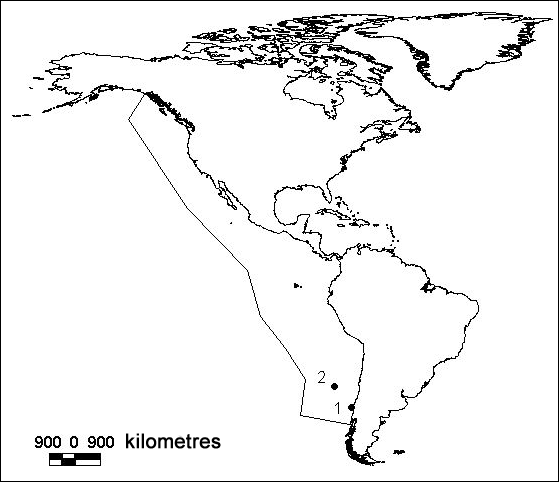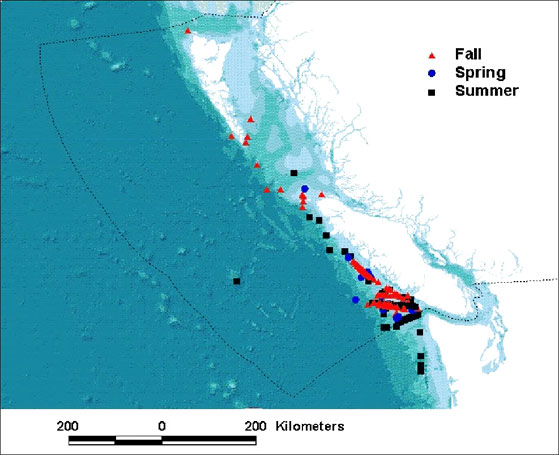Pink-footed shearwater (Puffinus creatopus) COSEWIC assessment and status report: chapter 4
Distribution
Global range
The Pink-footed Shearwater occurs primarily in the eastern Pacific, although there are records from New Zealand and Australia, and a specimen has been collected from the Atlantic coast of Argentina (Birdlife International 2003). The species breeds on three islands off the coast of Chile: Isla Mocha in Arauco Bay, 35 km offshore (50 km² in area); and 600 km to the northwest on Robinson Crusoe (Más á Tierra, 93 km²) and the very small Santa Clara in the oceanic Juan Fernandez Archipelago (AOU 1998) (Figure 2).
Along the Chilean coast the Pink-footed Shearwater is most common north of 40-42°S (Brown et al. 1975, Guicking et al. 2001). The marine range extends northwards along the coast of South and North America at least as far as the south coast of Alaska (AOU 1998) (Figure 2), although relatively few individuals have been seen north of Vancouver Island, British Columbia (Vermeer et al. 1989). Vagrants have been recorded west to the Hawaiian and Line Islands (Harrison 1983), and into the Gulf of Alaska. While Pink-footed Shearwaters are known to occur in all seasons off Peru and Chile, the species is usually only found in the North American part of its range during the boreal spring, summer and autumn.
Figure 2. Global distribution of the Pink-footed Shearwater Puffinus creatopus (to the east of line), based on maps from Birdlife International (2003).
- Isla Mocha colony,
- Juan Fernandez colonies.

Canadian range
The Pink-footed Shearwater occurs exclusively off the coast of British Columbia in Canada, with the north end of Vancouver Island likely representing the northern limits of where the species regularly occurs (Vermeer et al. 1989). The Pink-footed Shearwater is considered to be British Columbia’s second most numerous shearwater (Guzman and Myres 1983).
Literature on the occurrence of the Pink-footed Shearwater off the coast of British Columbia is sparse prior to the late 1960s. Martin (1942) described the species as rare off the coast of Vancouver Island; however, this was likely a function of poor offshore survey effort. During the 1940s Martin and Myres (1969) recorded the occurrence of the species off the west coast of Vancouver Island from late April through May, with numbers increasing and peaking from July and into August. Flocks of up to 20 individuals were frequently encountered during August around La Perouse and Swiftsure Banks (Martin and Myres 1969). Guzman and Myres (1983) reported concentrations of Pink-footed Shearwaters off central Vancouver Island in the spring of 1977-78; as well as large numbers off Vancouver Island, and the Olympic Peninsula, in the late fall of 1977. Sightings were concentrated around, and inside, the 90 m depth contour line. The Pink-footed Shearwater has also been recorded following Sooty Shearwaters (Puffinus griseus) well into Barkley Sound on the west coast of the Island (Hatler et al. 1978), and is infrequently observed in marine waters around the Queen Charlotte Islands (Haida Gwaii) in spring and summer (Harfenist et al. 2002).
Data collected since the early 1980s (Morgan et al. 1991 and Figure 3) indicates a seasonal pattern of occurrence that mirrors the results above. Numbers of Pink-footed Shearwaters increase off Vancouver Island during spring (March-May), and peak in the summer (June-July) through fall (August-October). In general, the species’ distribution tends to be closely associated with the outer edge of the continental shelf (the shelf being defined as waters out to the 200 m isobath) off the west coast of Vancouver Island, off the entrance of the Straight of Juan de Fuca, and during fall, off the coast of Haida Gwaii (Morgan et al. 1991 and Fig. 3). There are no winter (November-February) records for the species off the coast of British Columbia, although this may be a function of reduced survey effort during this period. Between spring and fall, there has been far more survey effort, with most occurring relatively close to the coast of British Columbia. Although there has been less survey effort beyond the shelf-break, the observed distribution of Pink-footed Shearwaters off British Columbia strongly mirrors that recorded elsewhere (see sections below). The extent of occurrence (EO) for the Pink-footed Shearwater, from the 200 m isobath to the coastline of BC (excluding east coast Vancouver Island waters, and inlets), is approximately 69,883 km².
At-sea survey effort has been inconsistent from year to year, on a spatial and temporal scale. All surveys are conducted from aboard ‘ships-of-opportunity’ (K. Morgan pers. comm. 2003), accounting for an uneven effort. As a result, it is difficult to delineate the exact range and the relative abundance of the species off the BC coast. In those marine areas where the species has not been recorded, as well as for areas that have not been surveyed, it is not possible to definitely say that the areas are not used by Pink-footed Shearwaters. Thus the Canadian area of occupancy (AO) is equivalent to the EO for this species.
On the basis of the EO and AO in Canada, and overall average density of Pink-footed Shearwaters/km²from at-sea surveys, it is estimated that approximately 21,000 Pink-footed Shearwaters use the defined area from June to October each year (CWS unpubl. data 2003). Although the total global population size is unknown, the estimate for BC likely represents a significant proportion of this, and highlights the importance of the waters off BC for the species during this time.
Figure 3. Seasonal sighting locations for the Pink-footed Shearwater Puffinus creatopus off the coast of British Columbia, Canada from 1980 through 2001. Light blue, grey and green shading indicate the continental shelf (200 m isobath) and slope areas.
